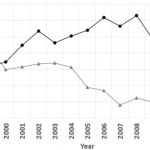Sign up to our newsletter Subscribe
Analysing Global Immunisation Expenditure

Sign up to our newsletter Subscribe


In this OHE Seminar Briefing, Dr Steven Pearson, President of ICER, sets out ICER’s early experiences of using HTA to assess gene therapy in the US, setting out four primary challenges. In a new OHE Seminar Briefing, Dr Steven Pearson,…
In this OHE Seminar Briefing, Dr Steven Pearson, President of ICER, sets out ICER’s early experiences of using HTA to assess gene therapy in the US, setting out four primary challenges.
In a new OHE Seminar Briefing, Dr Steven Pearson, President of the Institute for Clinical and Economic Review (ICER), discusses early experiences of using HTA to assess Gene Therapy, setting out four challenges.
First, uncertainty about clinical effectiveness makes it difficult for ICER to suggest an appropriate price. Pilot projects with some gene therapies involve five years of instalment payments. Instalments for longer periods are unrealistic in the US system. Uncertainty over the duration of effect led ICER’s panel to find CAR-T therapy Kymriah, for paediatric leukaemia, of “intermediate” value at $46,000 per QALY. Yescarta, at $136,000 per QALY for non-Hodgkin lymphoma, was between “intermediate” and “low” value for money.
Second, additional elements of value not usually included in cost-effectiveness analysis need to be considered. Three seem particularly relevant: i) first and only successful treatment; ii) the effect on society (schools, the community); and iii) effects on the infrastructure of care. ICER asks its appraisal committees to vote separately on whether each ‘potential other benefit’ is a significant factor to consider in determining the value for money.
Third, social values have to be integrated into value-based pricing. Three are particularly relevant to gene therapies: i) the severity of the condition; ii) lifetime burden of illness; and iii) first to offer improvement for patients. Taking the second and third factors into account, ICER’s panel majority found Luxturna, for genetic retinal disease causing blindness, to represent “intermediate long term value for money” at $480,000 per QALY from a societal perspective.
Finally, it is challenging to produce policy-relevant estimates, given the magnitude of gains produced by cures. ICER looked at emicizumab, a treatment for haemophilia A. The prior standard of care (bypassing agent prophylaxis) has an expected lifetime cost per patient of $99m. Cost-effectiveness analysis would suggest a price tag of up to $99m for the new treatment. Other options could include a price cap based on the QALY gain, or a “shared savings” approach whereby savings to the system are shared between the parties. The Briefing touches on the issues raised by AVXS-101 (Zolgensma) or spinal muscular atrophy, where the standard of care has been revolutionised by nusinersen (Spinraza) which has a list price of $750,000 for the initial year and $375,000 per year thereafter. If AVXS-101 is valued as a replacement for nusinersen as standard of care, then it might merit a value-based price of over $10m. Subsequent to the seminar, ICER released its Evidence Assessment in February 2019.
ICER recently launched, in January 2019, an international collaborative to develop new methods to guide value-based pricing of potential cures. This includes the National Institute for Health and Care Excellence (NICE) and the Canadian Agency for Drugs and Technologies in Health (CADTH). Public input was invited in February 2019 and ICER has stated that it will post a draft white paper for additional public comment in summer 2019, before finalising the white paper and methodology recommendations before the end of 2019.
Citation
Pearson S., 2019. Early Experience with Health Technology Assessment of Gene Therapies in the United States: Pricing and Paying for Cures. OHE Seminar Briefing 25. RePEc.
Related research
Jönsson, B., Hampson, G., Michaels, J., Towse, A., von der Schulenburg, J.-M.G. and Wong, O., 2018. Advanced therapy medicinal products and health technology assessment principles and practices for value-based and sustainable healthcare. The European Journal of Health Economics. DOI.
Hampson, G., Towse, A., Pearson, S.D., Dreitlein, W.B. and Henshall, C., 2018. Gene therapy: evidence, value and affordability in the US health care system. Journal of Comparative Effectiveness Research, 7(1), pp.15–28. DOI. RePEc.
Schaffer, S.K., Messner, D., Mestre-Ferrandiz, J., Tambor, E. and Towse, A., 2018. Paying for Cures: Perspectives on Solutions to the “Affordability Issue”. Value in Health, 21(3), pp.276–279. DOI.
Hampson, G., Mott, D., Shah, K., and Devlin, N., 2018. Public Preferences for Health Gains and Cures: A Discrete Choice Experiment. OHE Consulting Report, London: Office of Health Economics. RePEc.
Marsden, G. and Towse, A., 2017. Exploring the Assessment and Appraisal of Regenerative Medicines and Cell Therapy Products: Is the NICE Approach Fit for Purpose? OHE Consulting Report. RePEc.
An error has occurred, please try again later.
This website uses cookies so that we can provide you with the best user experience possible. Cookie information is stored in your browser and performs functions such as recognising you when you return to our website and helping our team to understand which sections of the website you find most interesting and useful.
Strictly Necessary Cookie should be enabled at all times so that we can save your preferences for cookie settings.
If you disable this cookie, we will not be able to save your preferences. This means that every time you visit this website you will need to enable or disable cookies again.
This website uses Google Analytics to collect anonymous information such as the number of visitors to the site, and the most popular pages.
Keeping this cookie enabled helps us to improve our website.
Please enable Strictly Necessary Cookies first so that we can save your preferences!
